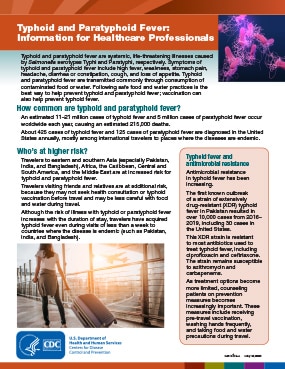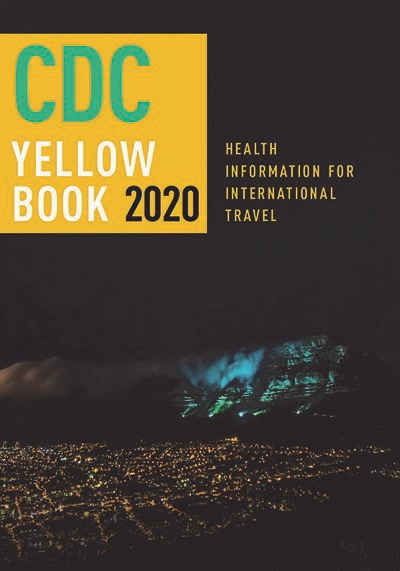Information for Healthcare Professionals
Cases of extensively drug-resistant Salmonella Typhi infection have been reported in the United States among people without recent international travel. Investigations are ongoing. CDC has updated empiric treatment recommendations for patients with suspected typhoid fever. For more information and updated treatment recommendations, see the CDC Health Advisory on Extensively Drug-Resistant Salmonella Typhi Infections Among U.S. Residents Without International Travel [PDF – 5 pages].
CDC’s Yellow Book is a reference for health professionals providing care to international travelers.
Typhoid and paratyphoid fever
Food and water precautions
Get the Yellow Book app

CDC’s Traveler’s Health site has information you can use to help your patients have a healthy trip, including:
Healthcare providers can view antimicrobial resistance data for Salmonella Typhi using antibiograms on Sanford Guide’s mobile app and website. The data come from CDC’s National Antimicrobial Resistance Monitoring System (NARMS) and are also available through NARMS Now, an interactive web tool containing data on selected enteric bacteria isolated from humans.
In this video, which is part of the CDC Expert Commentary Series on Medscape, Dr. Kevin Chatham-Stephens discusses drug-resistant typhoid fever, vaccination, and treatment options.

Read the Typhoid and Paratyphoid Fever Factsheet for Healthcare Professionals [PDF – 534 KB] to get more information about risk, diagnosis, treatment, and prevention.
Clinical Features
Typhoid fever and paratyphoid fever are bacteremic illnesses that have an insidious onset characterized by fever, headache, constipation or diarrhea, malaise, chills, and myalgias, with few clinical features that reliably distinguish them from a variety of other infectious diseases. Diarrhea may occur, and vomiting is not usually severe. A transient, maculopapular rash of rose-colored spots may be present on the trunk. Confusion, delirium, and intestinal perforation may occur in severe cases, typically after 2 to 3 weeks of illness. The incubation period for typhoid fever is typically 6 to 30 days, and 1 to 10 days for paratyphoid fever.
Diagnosis
Blood culture is the mainstay of diagnosis. Bone marrow cultures have sensitivity of 80% in some studies and can remain positive despite antibiotic therapy. Stool and urine cultures are positive less frequently. Multiple cultures are usually needed to identify the pathogen. Serologic tests, such as the Widal test, are not recommended because of the high rate of false positives.
Treatment
Typhoid fever and paratyphoid fever are treated with antibiotics.
Antimicrobial resistance in typhoid fever has been increasing. Most typhoid and paratyphoid fever infections diagnosed in the United States are caused by strains not susceptible to fluoroquinolones. Therefore, do not use fluoroquinolones for empiric treatment while awaiting susceptibility results. Patients who have traveled to Pakistan should be treated with azithromycin for uncomplicated suspected typhoid fever and carbapenems for severe or complicated disease. Treatment can be adjusted when culture and sensitivity results are available.
Etiologic Agent
U.S. estimates
An estimated 5,700 infections of Salmonella Typhi occur among people in the United States each year; an estimated 620 of these people are hospitalized. CDC has not made estimates for Salmonella Paratyphi.
Global estimates
An estimated 11–21 million cases of typhoid fever and 200,000 deaths occur worldwide each year. An estimated 5 million cases of paratyphoid fever occur worldwide each year.
Diagnosed cases
In the United States, about 350 patients are diagnosed with typhoid fever and 90 patients are diagnosed with paratyphoid fever annually. Most illnesses are in people who report recent travel to countries where the diseases are common, such as India, Bangladesh, and Pakistan. These cases do not account for people who do not seek medical care, who are not tested for either disease, or whose disease is not reported to CDC.
Sequelae
Without therapy, the illness can last for 3 to 4 weeks and death rates range between 12% and 30%. Relapse occurs in up to 10% of untreated patients approximately 1 to 3 weeks after recovering from the initial illness and is often milder than the initial illness. A chronic carrier state, in which stool or urine cultures for Salmonella Typhi remain positive for more than one year, occurs in up to 5% of infected people.
Transmission
Typhoid fever and paratyphoid fever are transmitted commonly through the consumption of drinking water or food contaminated with the feces of people who have typhoid fever or paratyphoid fever or of people who are chronic carriers of the responsible bacteria.
Risk Groups
Risk is very low in the United States, higher among international travelers, and highest among people living in places with poor sanitation and hygiene. Most typhoid fever and paratyphoid fever patients in the United States report international travel in the 30 days before their illness; most of these patients traveled to South Asia (e.g., India, Bangladesh, Pakistan).
Surveillance
CDC has conducted surveillance for typhoid fever since 1975 and paratyphoid fever since 2008. About 350 culture-confirmed cases of typhoid fever and 90 culture-confirmed cases of paratyphoid fever were reportedly annually to CDC’s National Typhoid and Paratyphoid Fever Surveillance (NTPFS) system during 2008–2015. These cases do not account for people who do not seek medical care, who are not tested for either disease, or whose disease is not reported to CDC.
CDC tracks changes in antimicrobial resistance among Salmonella causing typhoid fever and paratyphoid fever through the National Antimicrobial Resistance Monitoring System (NARMS).
Trends
Typhoid fever cases in the United States decreased slightly from 2008 through 2015. Since 2016, reported cases have increased slightly.
Challenges
Reduced susceptibility to fluoroquinolones (e.g., ciprofloxacin) and the emergence of multidrug resistance has complicated treatment of infections, especially those acquired in South Asia. There have been reports of sporadic ceftriaxone-resistant Salmonella Typhi infections and at least one documented outbreak. An outbreak of extensively drug-resistant typhoid fever in Pakistan is ongoing.
CDC offers testing for Salmonella Typhi and Salmonella Paratyphi.
- Learn who may submit a specimen
- Select a test order
- Download a submission form
- Find packing and shipping instructions
- Learn how to avoid time-consuming errors with our training materials
- Get answers to commonly asked questions
NOTE: CDC accepts specimens for analysis only from state public health laboratories and other federal agencies. Private healthcare providers and institutions must submit specimens to their state public health laboratory for processing.

